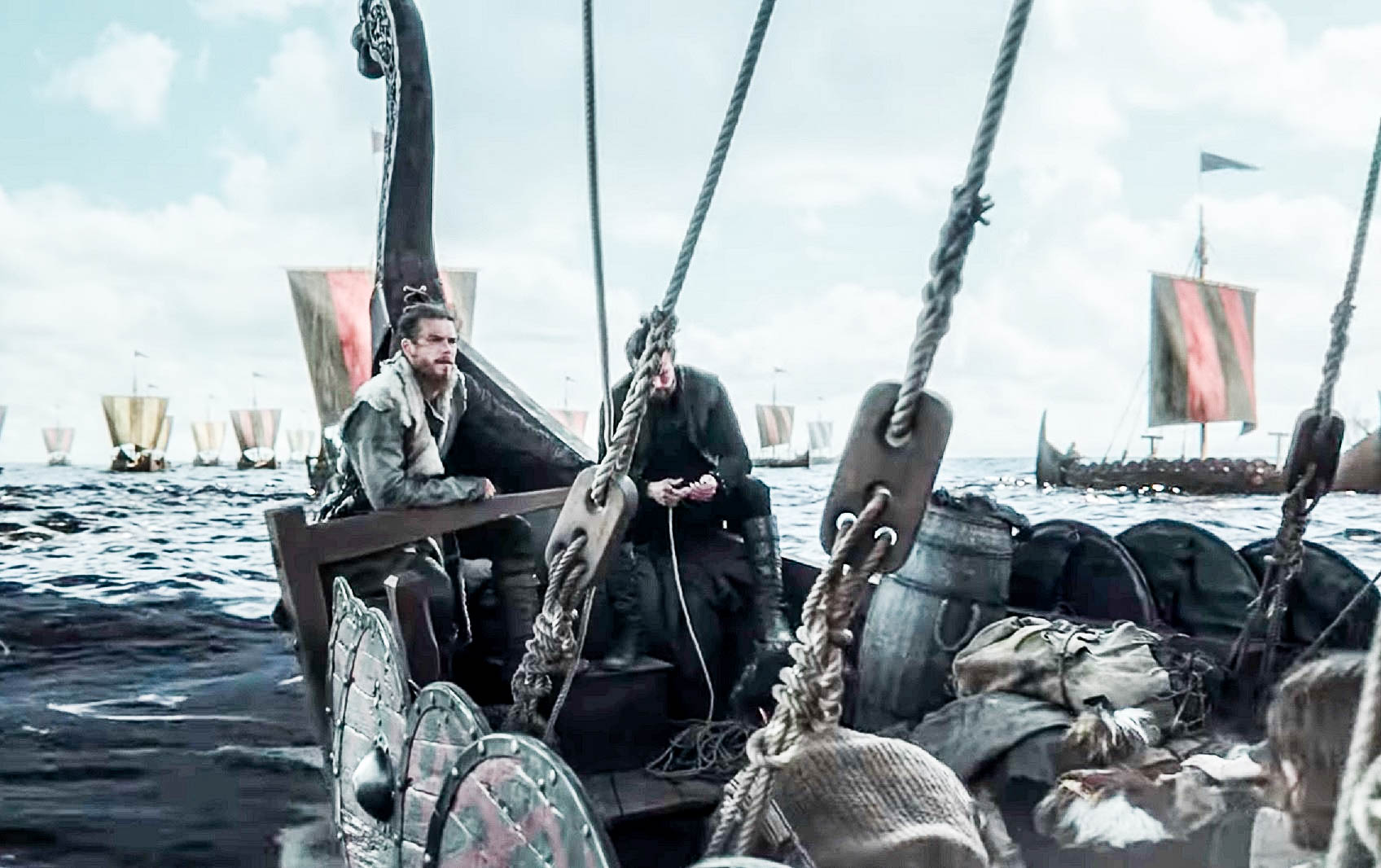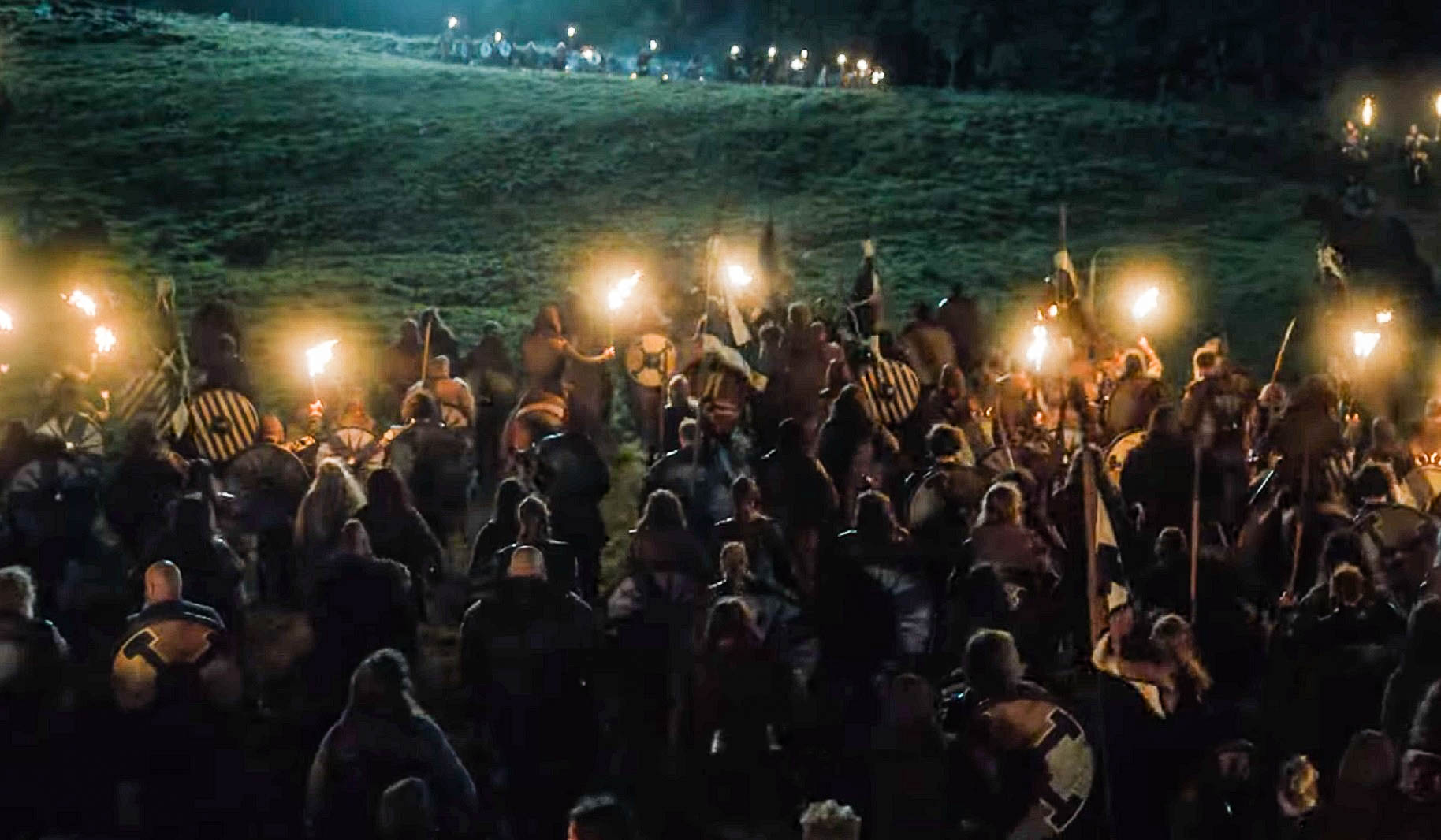Harald Hardrada was King of Norway from 1046 to 1066. But his biggest accomplishments were on the battlefield, not the throne. Whether he was fighting off pirates in the Mediterranean Sea, invading England, or terrorizing his own subjects, Harald was a Viking, through and through. And these are the hard-hitting facts that make him the last true Viking.
Harald Hardrada Facts
1. He Was Savage
Harald Hardrada was actually born Harald Sigurdsson—he had to earn the epithet Hardrada. Different translations over the years have given Harald’s epithet as “tyrannical”, “ruthless”, and “savage,” among others. Given these bloody and berserk facts about the last Viking, he clearly earned that name. Many, many times over.

2. He Was A Poet
Over the course of his life, Harald developed an aura of invincibility on the battlefield. A contemporary historian of his remarked that he was far stronger and more massive than other men. But he had a surprising softer side. Even though all Norwegian kings wrote poetry, he was “the only one who showed a decided talent”. Harald's real gifts, however, involved a sword.
 Vikings: Valhalla (series), MGM Television
Vikings: Valhalla (series), MGM Television
3. He Was An Unlikely King
Harald Hardrada was born to Åsta Gudbrandsdatter and her second husband Sigurd Syr around 1015. Even though his father was a wealthy and powerful chieftain in the area, Harald wasn’t an obvious choice as the future king of Norway. Additionally, from the looks of it, he got his ambition from his mother’s side of the family.
 Vikings: Valhalla (series), MGM Television
Vikings: Valhalla (series), MGM Television
4. He Had A Role Model
Through his mother, Harald was the youngest half-brother of King Olaf II of Norway. While his older brothers seemed content to stick to the farm, Harald had far greater ambitions. He wanted the life of a true Viking—a life on the battlefield. And, in his restless youth, he turned to the only sibling who could show him the Viking way.
5. He Rushed To His Brother’s Side
Harald got his wish in 1030. Cnut the Great had deposed Harald’s older half-brother Olaf in 1028. When Harald learned that Olaf was trying to regain his throne in 1030, the 15-year-old rallied 600 men to join him and his brother in the coming battle. But he would learn that victory and Valhalla came at a terrible cost.
 Vikings: Valhalla (series), MGM Television
Vikings: Valhalla (series), MGM Television
6. He Tasted Defeat
Things didn’t exactly go according to plan for Harald. In fact, it was a complete disaster. The brothers lost the Battle of Stiklestad. According to some sources, Olaf II fell in battle while others say that his men turned on him following the defeat. Either way, despite proving himself a capable fighter, Harald lost his older brother and role model and only narrowly escaped with his own life.
7. He Fled Far Away
Following the defeat at the Battle of Stiklestad, Harald fled north and nursed his wounds for a whole month. Eventually, he found his way to Kievan Rus' where his distant relative had married Grand Prince Yaroslav the Wise. And wise he was. The Grand Prince spotted Harald’s knack for battle and made him a captain in his forces.
8. He Developed A Bad Reputation
Perhaps for his own safety, Harald tried to conceal his royal lineage. But he and the men he led quickly developed a fierce reputation. By the time Harald struck out on his own and went to Constantinople, then the capital of the Eastern Roman Empire, everyone knew exactly who he was. And exactly why they should fear him.
 Vikings: Valhalla (series), MGM Television
Vikings: Valhalla (series), MGM Television
9. He Traveled Far And Wide
In Constantinople, Harald and his men joined the elite Varangian Guard. Even though the Varangian Guard was meant to be the Byzantine emperor’s personal bodyguard, Harald and his fearsome men traveled all across the empire. Historical records show that he was fighting in nearly every corner of the known world. And smashing right through it.

History's most fascinating stories and darkest secrets, delivered to your inbox daily.
10. His Reputation Preceded Him
Under the Byzantine Empire, Harald fought against pirates in the Mediterranean Sea and captured nearly 100 strongholds that reached as far East as Iran. And his reputation traveled as far north as Iceland, where the poet, politician, and historian Snorri Sturluson called him “leader over all the Varangians”. Word didn't travel fast back then, but Harald Hardrada's deeds made him famous the world over.
But the life of a warrior wasn't easy.
11. He Fought Friend And Foe
In 1038, Harald’s unique skill set with a sword brought him to Sicily to oust the Saracen settlers. While there, he fought alongside fellow mercenary William Iron Arm. But then, just three years later, Harald found himself fighting (and losing) against his one-time ally. But his reputation was still that of a fearsome fighter.
 Vikings: Valhalla (series), MGM Television
Vikings: Valhalla (series), MGM Television
12. He Received High Honors
Emperor Michael IV blamed Harald’s defeat at the hands of William Iron Arm on an incompetent general, not on him. And, as a sign of his gratitude, Emperor Michael IV promoted Harald—but then things took a dark turn. Fortunes could change quickly in Byzantium, and soon, Harald fell out of favor in the Byzantine capital. Suddenly, Harald had to escape for fear of his life.
 Vikings: Valhalla (series), MGM Television
Vikings: Valhalla (series), MGM Television
13. He Was A Prisoner
Part of the reason for Harald’s success in the Byzantine Empire had to do with his close relationship with Emperor Michael IV. So, when Michael IV passed, it’s not surprising that Harald’s fortunes took a turn for the worse. When Emperor Michael V took over, he had Harald thrown in prison. But no one quite knows why.
 Vikings: Valhalla (series), MGM Television
Vikings: Valhalla (series), MGM Television
14. He Helped Himself To The Purse
According to the sagas, Michael V had Harald thrown in prison for essentially being a Viking. The newly-installed emperor claimed that Harald had attempted to defraud the emperor of his treasure. It’s entirely possible that is true, seeing as though Harald had helped the emperor’s predecessor plunder most of the loot anyway. But there was a more scandalous rumor as well...
 Vikings: Valhalla (series), MGM Television
Vikings: Valhalla (series), MGM Television
15. He Wooed Empresses
Another version of events gives an alternate—albeit still very Viking—reason for Harald’s imprisonment. Allegedly, the Empress Regent Zoë Porphyrogenita had Harald thrown in the clink when he asked for her niece’s hand in marriage. You see, the empress wanted Harald for herself. I'm not sure why though: Harald didn't exactly have the best track record with women.
16. He Was A Defiler
Other accounts of Harald’s imprisonment seem likely, but they only came out years later. They variously give the reason for his imprisonment as manslaughter (we are, after all talking about a Viking) and for defiling of a noblewoman. The real mystery, however, isn’t how Harald ended up in prison. The real question is, how on earth did he get out?
 Vikings: Valhalla (series), MGM Television
Vikings: Valhalla (series), MGM Television
17. His Friends Came To His Rescue
Unlike Michael IV, Michael V was wildly unpopular. Some sources suggest that Harald escaped prison with the help of his friends in the Varangian Guard during the bloody revolt that ended Michael V’s reign. The sources even claim that Harald played a central role in removing Michael V from power. In the most literal sense.
 Vikings: Valhalla (series), MGM Television
Vikings: Valhalla (series), MGM Television
18. He Took An Eye For…An Imprisonment
Some sources claim that Michael V fled the palace in fear and took refuge in a monastery where he took his monastic vows. Other sources, however, suggest that Harald gave him the Viking treatment and dragged him from the palace to the monastery after, presumably, gouging his eyes out. An eye (or two) for an imprisonment seems fair.
Whatever happened, one thing's for sure: Harald Hardrada was back on the scene.
 Vikings: Valhalla (series), MGM Television
Vikings: Valhalla (series), MGM Television
19. He Was A Rich Man
There may have been some truth to Michael V’s allegations that Harald had been, shall we say, helping himself to the emperor’s money. During his time serving the empire, he became fabulously wealthy, probably by engaging in “palace plunder”. And now that he had his fortune—safely stashed in Kievan Rus'—he could finally afford revenge.
 Vikings: Valhalla (series), MGM Television
Vikings: Valhalla (series), MGM Television
20. He Was Grounded
Following Michael V’s fall from power, the Empress Regent Zoë Porphyrogenita ascended to the throne. Harald asked Zoë to take his leave and return to Norway, but the empress declined, giving credence to the theory for his imprisonment being that she had a thing for him. But Vikings don’t get tied down.
 Vikings: Valhalla (series), MGM Television
Vikings: Valhalla (series), MGM Television
21. He Packed His Bags Anyway
Undeterred, Harald decided to make yet another daring escape. He loaded up two ships with his supporters—likely from the Varangian Guard—and set sail for Kievan Rus'. However, even before he hit the open water, the Byzantines raised the cross-strait iron chains. But if there’s one thing a Viking can do, it’s navigate rough waters.
 Vikings: Valhalla (series), MGM Television
Vikings: Valhalla (series), MGM Television
22. He Glided Over Obstacles
Harald’s second ship, mostly containing his supporters, got caught in the cross-strait iron chains and sunk to the bottom of the Bosphorus. Harald, however, managed to sail his ship straight over the chains and into the open waters. Little did he know, however, that his quest to reclaim his birthright had only just begun.
 Vikings: Valhalla (series), MGM Television
Vikings: Valhalla (series), MGM Television
23. He Fell Madly In Love
Harald returned to Kievan Rus' shortly after his daring escape from Constantinople. In addition to his fortune, Harald was reunited with and married a woman named Elisabeth, or Elisiv. Even though it was likely a pre-arranged marriage, Harald seemed truly in love, composing poetry like “Yet the goddess in Gardarike / will not accept my gold rings”.
 Vikings: Valhalla (series), MGM Television
Vikings: Valhalla (series), MGM Television
24. He Wasn’t Good Enough
Harald’s time fighting for the Byzantine Empire might actually have been an elaborate courtship. Elisabeth was Yaroslav the Wise’s daughter and he initially disapproved of the match because Harald was too poor. And kingdom-less. He had managed to solve his first problem—and he was about to solve that second one and fulfill his destiny.
 Vikings: Valhalla (series), MGM Television
Vikings: Valhalla (series), MGM Television
25. His Fortune Weighed A Ton
With his new wife and fortune in tow, Harald sailed from Kievan Rus' back to Norway for the first time since his defeat at the Battle of Stiklestad. Despite his eagerness to reclaim his half-brother’s kingdom, the trip was slow going—though not because of rough seas. Allegedly, Harald had so much gold that it destabilized the ship. First world problems, amirite?
 Vikings: Valhalla (series), MGM Television
Vikings: Valhalla (series), MGM Television
26. His Nephew Took His Crown
It’s not clear whether or not Harald knew when he returned to Norway that his nemesis, Cnut the Great, had passed some ten years earlier. Magnus the Good, his half-brother’s illegitimate son, had been on the throne ever since. But family or not, Harald would retake his throne like a true Viking—with steel and blood.
27. He Assembled His Forces
Once he arrived in Norway, Harald joined forces with his other nephew and pretender to the throne, Sweyn. For good measure, they invited the King of Denmark to join their ranks and overthrow Magnus the Good. With their forces assembled, they started in the oldest of Viking traditions—raiding the coastline. But this tried and true strategy backfired horribly.
 Vikings: Valhalla (series), MGM Television
Vikings: Valhalla (series), MGM Television
28. He Wasn’t Very Popular
Harald and his conspirators had hoped that by attacking the coast while Magnus was away, the populace might turn to them for protection. But Magnus’ subjects were too loyal to be swayed—they did, after all, call him Magnus the Good. And when Magnus returned to Norway with his forces, Harald learned how “good” he really was.
 Vikings: Valhalla (series), MGM Television
Vikings: Valhalla (series), MGM Television
29. He Bought His Kingdom
As a true Viking, Harald was willing to duke it out on the battlefield and to the bitter end with his nephew. But Magnus, ever the good ruler, had a better (bloodless) idea. Magnus agreed to be co-ruler of Norway with Harald…in exchange for half of his massive fortune. Harald agreed to the deal—but not without making his displeasure known.
 Vikings: Valhalla (series), MGM Television
Vikings: Valhalla (series), MGM Television
30. He Wasn’t Easy To Work With
As co-rulers of Norway, Harald and Magnus held separate courts. And, despite forking over half of his fortune to his nephew, Harald still found himself as the “junior” in the co-kingship. Clearly displeased with the arrangement, whenever Harald met with Magnus on important matters of state, their meetings nearly erupted into blows.
 Vikings: Valhalla (series), MGM Television
Vikings: Valhalla (series), MGM Television
31. He Had A Stroke Of Luck
Fortunately for Harald, the tenuous deal that he had reached with his nephew was about to turn in his favor. While setting up a campaign to go raiding in England, Magnus fell overboard and drowned. Or he fell ill while at sea and didn’t recover...or he fell off his horse and broke his neck. No one really knows what happened. But I doubt Harald cared. His time had finally come.
 Vikings: Valhalla (series), MGM Television
Vikings: Valhalla (series), MGM Television
32. He Claimed What Was His
Allegedly, knowing that he was drawing his final breaths, Magnus named Harald as his sole successor in Norway. Additionally, he named Sweyn as his successor in Denmark. However, Harald had different ideas. Once the news of Magnus’ demise reached Harald, he declared himself King of Norway and Denmark—and prepared to stake his claim.
 Vikings: Valhalla (series), MGM Television
Vikings: Valhalla (series), MGM Television
33. He Was Still No Good
Even with his nephew out of the picture, Harald still couldn’t outlive Magnus’ legacy. When Harald opposed a royal burial for Magnus in Norway, Einar—one of his many detractors—said, “to follow Magnus dead was better than to follow any other king alive”. And given the bloodshed that followed, Einar wasn’t wrong.
 Vikings: Valhalla (series), MGM Television
Vikings: Valhalla (series), MGM Television
34. He Went Back To His Old Ways
Harald’s true intention was to recreate a North Sea Empire, just as Cnut the Great had. And he lost no time staking his claim over Denmark—or, at least, trying to. Before Magnus’ body was even cold, Harald turned on his former ally, Sweyn, and invaded Denmark. But his usual “raid, pillage, and plunder” strategy proved useless this time around.
 Vikings: Valhalla (series), MGM Television
Vikings: Valhalla (series), MGM Television
35. He Ruined Things
Harald’s brutal raids along the Danish coastline failed to gain him the Danish crown. But they did earn him a different kind of legacy altogether. One of the towns that Harald raided was the prosperous and growing trading town of Hedeby. He so devastated the town that it never recovered and, eventually, turned to ruin.
 Vikings: Valhalla (series), MGM Television
Vikings: Valhalla (series), MGM Television
36. He Had Nothing To Show For His Effort
Even though Harald scored countless victories between 1048, when he assumed the throne in Norway, and 1064, he had nothing to show for it. Nothing, that is, except for blood on his sword. His forces, however, had been unable to occupy Denmark. So, Harald gave his conquest of Denmark one final try. And it nearly broke both his kingdom and Sweyn’s.
 Vikings: Valhalla (series), MGM Television
Vikings: Valhalla (series), MGM Television
37. He Was Tricked
Harald and Sweyn agreed to a winner-take-all battle, the Battle of Niså. At the agreed-upon time, Harald arrived with a fleet of 300 ships but, after Sweyn failed to show up, he sent his elite men back home. But he had been deceived. Just then, when Harald’s best men had sailed out of sight and signal range, Sweyn appeared with his full force.
 Vikings: Valhalla (series), MGM Television
Vikings: Valhalla (series), MGM Television
38. He Beat All The Odds
Undeterred, Harald prepared to meet Sweyn in battle. After all, he had fought on the harshest frontiers of the Byzantine Empire. The battle that ensued proved to be one of the bloodiest and most brutal of Harald’s life but, despite the odds, he emerged victorious. Nevertheless, Sweyn managed to escape to fight another day.
 Vikings: Valhalla (series), MGM Television
Vikings: Valhalla (series), MGM Television
39. He Focused Inwards
Tired at the expense (in lives lost and money spent) of constantly fighting the Danes, Harald reached a peace agreement with Sweyn. But he still had an appetite for bloodshed and his own subjects were beginning to look like an appealing target. With his dreams of a North Sea Empire quashed, Harald turned his attention inwards.
 Vikings: Valhalla (series), MGM Television
Vikings: Valhalla (series), MGM Television
40. He Was A Man Of Faith
Despite his decidedly “unchristian-like” behavior, Harald was openly and devoutly Christian. Nevertheless, he was more closely aligned with the eastern tradition from Kievan Rus' and Byzantium. And he had no qualms about voicing his opposition to the pope and his representatives whenever they showed up in his neck of the woods.
 Vikings: Valhalla (series), MGM Television
Vikings: Valhalla (series), MGM Television
41. He Was God’s Right Hand
Whenever the Vatican sent papal representatives to Harald’s Norwegian kingdom, they received a decidedly frosty, Nordic welcome. For example, Harald told one visiting Catholic clergyman that he “did not know of any other archbishop or lord of Norway than the king himself”. And he behaved like judge, jury, and executioner.
 Vikings: Valhalla (series), MGM Television
Vikings: Valhalla (series), MGM Television
42. He Demanded Fealty
Throughout his reign, Harald had to deal with ambitious nobles and rebellious hinterland villages. For example, when farmers in the Uplands refused to pay their taxes to Harald because they had already paid them to Haakon Ivarsson, Harald reacted. Or, one might say that he drastically overreacted—in epic berserker style.
 Vikings: Valhalla (series), MGM Television
Vikings: Valhalla (series), MGM Television
43. He Was A Little Strict
Harald considered Haakon Ivarsson’s tax collection to be an act of defiance. So he sought out Ivarsson and quickly put him to the sword. He then returned to the Uplands and burned farms and entire towns and horrifically maimed anyone that refused to pay taxes. Fortunately for his subjects, he quickly turned his attention elsewhere.
44. He Crossed The Sea
After giving up on Denmark, Harald focused all of his bloodlust on England. Through his nephew, Magnus the Good, Harald had a tenuous claim on the English throne. But, tenuous or not, he decided that he wanted it. After preparing a massive fleet, he named his son Magnus as the King of Norway and set sail for England.
 Vikings: Valhalla (series), MGM Television
Vikings: Valhalla (series), MGM Television
45. He Gathered All Of His Forces
Harald joined forces with his brother, Tostig Godwinson, and amassed a force of over 15,000 men. Once they were ready, the brothers began doing what Vikings do best, i.e. raiding English coastlines. At first, the English towns refused to surrender to Harald and his reign of tyranny. So, he did the next thing that Vikings do best.
 Vikings: Valhalla (series), MGM Television
Vikings: Valhalla (series), MGM Television
46. He Crushed His Enemies
Harald burned the towns that refused to surrender to his overwhelming forces. In response, Morcar of Northumbria and Edwin of Mercia decided to rally their forces against the invading Viking. However, Harald was ready for them and completely overwhelmed their forces. But it would be his—and all Vikings’—last victory in England.
Harald was finally about to meet his match.
 Vikings: Valhalla (series), MGM Television
Vikings: Valhalla (series), MGM Television
47. He Made A Fatal Error In Judgement
Thinking that he had secured victory, Harald returned to the conquered town of York. Because he only expected to meet townsfolk, Harald and the fraction of his army that followed him only traveled in light armor. However, much to their surprise, when they arrived in York, they found themselves face-to-face with a formidable foe.
 Vikings: Valhalla (series), MGM Television
Vikings: Valhalla (series), MGM Television
48. He Was Doomed
Unbeknownst to Harald, Harold Godwinson, the King of England, had assembled his heavily armored forces at Stamford Bridge. Because Godwinson was blocking Harald from his 100s of ships, he had no choice but to meet the king of England in battle—under-armored, out-manned, and unprepared. It would be an epic ending for an epic Viking.
49. He Was A True Berserker
By all accounts, Harald met the challenge as a true Viking should—i.e., fearlessly. In a state of berserkergang, he threw off his armor, grabbed his sword with both hands, and charged the English men. Despite his perceived invincibility in battle, Harald caught an arrow in the neck early in the battle and his army was all but wiped out.
 Vikings: Valhalla (series), MGM Television
Vikings: Valhalla (series), MGM Television
50. His Son Brought Peace
In the end, Harald entered the gates of Valhalla and Harold Godwinson spared Harald’s son, Olaf, after the battle. What remained of Harald’s army sailed back home to Norway, just a fraction of its former size. As a direct opposite to Harald’s brutal reign, his son Olaf ruled Norway for nearly 30 years as Olaf the Peaceful.
 Vikings: Valhalla (series), MGM Television
Vikings: Valhalla (series), MGM Television




















